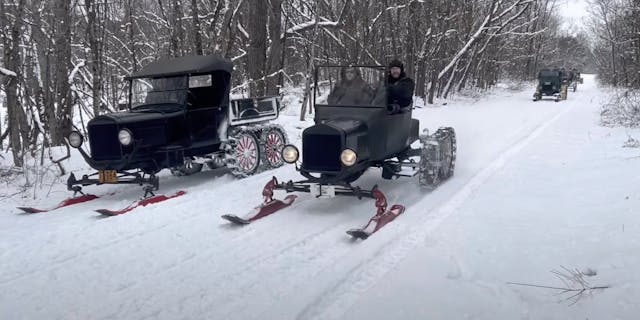Media | Articles
Just add skis: Ford’s Model T is (still) the perfect one-car solution

The vast majority of drivers view cars as utility items—and rightly so. Though automotive enthusiasts may derive joy from the experience provided, these four-wheel wonders are primarily seen as functional products designed with a singular purpose. Well, a purpose that diversified to successfully cover the globe. Before our well-maintained roadways became ubiquitous, the automobile was in transition from a novelty for the wealthy to a useful object for everyone.
There were a variety of attempts to fit the machine to the terrain at hand, the coolest of which are the conversion kits for Ford Model T cars and trucks. Making a Tin Lizzy into snow-savvy machinery creates the perfect intersection between utility and an enthusiast’s toy.
Don’t believe me? Just have a look at these things in action:
That’s right, even a century later these snowmobile conversions are still motoring through the winter. The owner of the video above, Ryan Tebo, is no stranger to vintage and Brass Era Fords. He even drove coast-to-coast in a Ford Model A back in 2020. My interest in snow machines has been growing after I dug into one of the smallest snow machines on the market, so it was only time before I crossed paths with the first snow machine. Digitally, at least.
Marketplace
Buy and sell classics with confidence
These early snow-conquering cars based on the Ford Model T (and Model A!) were created by adding a second rear axle. This change moves the factory axle forward slightly, turning it into a bogey axle. The rear-most axle is typically a Ruckstell two-speed rear end. It is the least obvious change, but as Tebo explained, the Ruckstell provides an extra low ratio, or a granny gear as it’s sometimes called. The third axle is not an overdrive unit, like many think, and considering a factory Model T only has 20 horsepower, the under-drive ensures the snowmobile moves adequately considering its extra weight, and drag.
“It’s also highly conditions-dependent,” said Tebo during our chat on the phone. “There needs to be a good hardpack snow or you probably aren’t going anywhere. Note how ropes are tied around the rear wheels. That is there to help the wheel have traction inside the track. It was commonplace to use chains, but that destroyed the tracks, so most of us switched to rope.”
That drive traction is critical, as the weight distribution of these vehicles isn’t exactly ideal. Because of the large engines—essentially, lumps of iron—and transmissions set forward in the Ford’s chassis, the skis hold up the majority of the vehicle’s weight. This causes the steering to be more of a suggestion and also leads to the skis following ruts easily.
Luckily, if things get out of hand, there is so much drag that just putting the snowmobile in neutral is enough to come to a quick stop. No brakes needed, but of course they are still there: Model Ts have rear brakes, with friction material (and drum) located in the transmission instead of at the wheels.

One of the more interesting bits that Tebo mentioned was that the kits were available in two versions, only varying in track width. Not the width of the rear tracks, but the distance between the front skis. This was done to match the two standards of sleigh runners of the time: If a neighbor still used a horse-drawn sleigh, you could take advantage of the trail they cut, rather than relying on making your own.
As they were back then, these conversions remain automotive oddities. But today the snowmobile conversion has transitioned this oddity to more of a pure novelty—like most vintage cars. How often do you see a vintage car on a modern road? Isn’t it even cooler to have an automotive novelty that doubles duty on the snow trails?
If you are interested in seeing these awesome machines and their owners in person, check out the Model T Ford Snowmobile Club annual meeting, taking place February 3–5 in Bingham, Maine. Spectating and rides are free, so if you’re in the area there is no reason not to see these awesome machines in their element.
Check out the Hagerty Media homepage so you don’t miss a single story, or better yet, bookmark it.











Hagerty should do a video series with a modern take on this idea… to a VW Beetle or Fiero as that would change the weight distribution dynamics.
Awesome, I am a member . Wish North Dakota was closer!!!! Great Job and Thanks for Sharing 👍👍👍🇺🇸